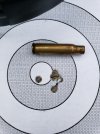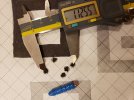Mitty38
Well-Known Member
If I may interject something.
I know the PO is trying not to pound cast or cast the chamber.
Now what Ian said is very important. Enveloping what has been discovered to be our holy Grail.
Now mind you, I never went for the kind of velocity or accuracy you are reaching for. I am just a hobbie, and hunting shooter.
However I have been able to accomplish an accurate load for my 450BM starting with a bullet that cast .002 over bore size.
I was able to size down to bore size. Powder Coat, then size down again. Accomplishing bore size bullet. Built the best load I could. 2moa.
Then tried .001 over bore. Got me to 1.25 moa.
By enlarging the sizer then buying a second one, which I enlarged also. I was able to go up in size .001 at a time . Repeating this over and over.
Finally at .003 over, I got under 1moa. Enlarged the sizer .001 more to .004 over,(with the help of Powder Coat) accuracy went way down.
So bought a .003 over, sizer since I had ruined my other one, hollering it out to .004 over. Backed my size down to .003 over. Got a Good consistent load. 1 moa.
Now It would have been a lot easier to figure out if I had casted. But I still got it.
Now if I was going for better then 1MOA.
I would pound cast it and have these fellows help me figure out the right Metplate and bullet design.
Don't know if this helps but thought I might interject.
I know the PO is trying not to pound cast or cast the chamber.
Now what Ian said is very important. Enveloping what has been discovered to be our holy Grail.
Now mind you, I never went for the kind of velocity or accuracy you are reaching for. I am just a hobbie, and hunting shooter.
However I have been able to accomplish an accurate load for my 450BM starting with a bullet that cast .002 over bore size.
I was able to size down to bore size. Powder Coat, then size down again. Accomplishing bore size bullet. Built the best load I could. 2moa.
Then tried .001 over bore. Got me to 1.25 moa.
By enlarging the sizer then buying a second one, which I enlarged also. I was able to go up in size .001 at a time . Repeating this over and over.
Finally at .003 over, I got under 1moa. Enlarged the sizer .001 more to .004 over,(with the help of Powder Coat) accuracy went way down.
So bought a .003 over, sizer since I had ruined my other one, hollering it out to .004 over. Backed my size down to .003 over. Got a Good consistent load. 1 moa.
Now It would have been a lot easier to figure out if I had casted. But I still got it.
Now if I was going for better then 1MOA.
I would pound cast it and have these fellows help me figure out the right Metplate and bullet design.
Don't know if this helps but thought I might interject.
Last edited:


